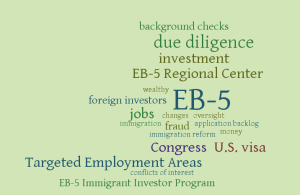
EB-5 word cloud generated by WordItOut.
Late last year, Congress was working furiously to prepare a budget that would avoid a government shutdown. As legislators debated and worked, time was running out for the popular EB-5 Immigrant Investor Program, which would expire in December 2015 if Congress did not renew it.
The EB-5 program was under scrutiny at the time, and representatives were looking at ways to both provide the program with more oversight and reduce the fraud that had made headlines across the country.
In the end, Congress passed a last-minute omnibus spending bill that included an extension of the EB-5 program in its current form. The extension, which goes through September 2016, was expected, but many industry leaders also expected Congress to address the fraud concerns.
Now that the budget battle is over for a few months, members of Congress are once again looking at the EB-5 program and the issues that have plagued it despite the money it has brought into the country. The EB-5 program allows those living in other countries to obtain a U.S. visa by investing a minimum of $500,000 into a new business venture that must create or preserve at least 10 full-time jobs for U.S. workers. The businesses can be as simple as an apartment building or as large as a multimillion-dollar project that includes dozens of investors. These larger projects are organized by EB-5 regional centers.
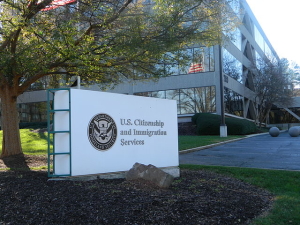
U.S. Citizenship and Immigration Service building, courtesy of Wikimedia Commons user Gulbenk, CC BY-SA 3.0.
Each year, only 10,000 visas are granted through the EB-5 program. However, that does not mean that 10,000 EB-5 investor applicants are granted visas each year. Each investor can receive additional visas for a spouse and children, meaning that the total number of EB-5 applications that are approved each year is closer to 3,500.
The program is incredibly popular with foreign investors, and because of the low number of applications accepted, approximately 19,000 applications are still waiting to be reviewed. It’s a tremendous backlog that won’t be eased anytime soon unless the 10,000-visa cap is increased. The program has seen an increase in applications since news of the possible program changes were announced last year.
The 25-year-old program has raised more than $4.2 billion in private investments and created upwards of 77,000 jobs. However, fraud allegations have given the program a poor reputation. Opponents of the program have also expressed concerns about the way money is invested.
Currently, applicants must contribute $1 million toward a capital investment unless they are investing in what are considered high unemployment or rural areas. Investments in those areas, known as Targeted Employment Areas or TEAs, only require $500,000. One complaint has been that lawmakers have been able to make investments look more attractive by designating areas as TEAs even when they include prosperous parts of a large city.
Congress is now debating two bills to reform the EB-5 program. Last month, Senator Chuck Grassley (R-IA) began a Senate Judiciary Committee hearing by reading a list of problems stemming from the EB-5 program. One issue that comes up often is that due diligence on a project is not always carried out adequately, resulting in investors losing their money and lawsuits often following. To address this issue, Greenfield Advisors started an EB-5 due diligence practice recently.
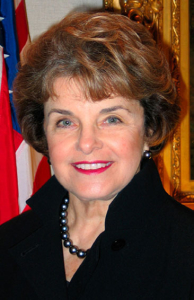
Senator Dianne Feinstein
Some in Congress want to see the program eliminated. Democratic Senator Dianne Feinstein (D-CA) has been a vocal critic. She is opposed to the idea of selling visas because it allows those with more money to immigrate to the country ahead of others also looking to acquire a visa. Proponents of the EB-5 program are quick to cite the billions in investments and thousands of jobs created.
A bill has already been brought up that would reform the EB-5 program while also extending it through September 2020. Senator Patrick Leahy (D-VT) and Senator Grassley introduced Senate Bill 1501 last June to make a number of changes to the current program:
- SB 1501 would allow for more extensive background checks on investors and the funds they are willing to put forward.
- SB 1501 would require regional centers to submit to a background check and state any possible conflicts of interest that may arise.
- Each TEA would be limited to a single census tract to prevent TEA boundaries being altered to entice investments into wealthy areas bordered by poorer areas.
- The minimum investment for a TEA project would be increased to $800,000, and non-TEA projects would require an investment of $1.2 million.
The bill is still being discussed in committee, but many of these ideas were floated last year during the initial talks. Changes will more than likely happen as the Senate and House both debate such bills in the coming months. We’ll keep you updated and let you know of any developments.
Do you see the bill being accepted as it was presented? If not, what changes are you expecting? Let us know in the comments.

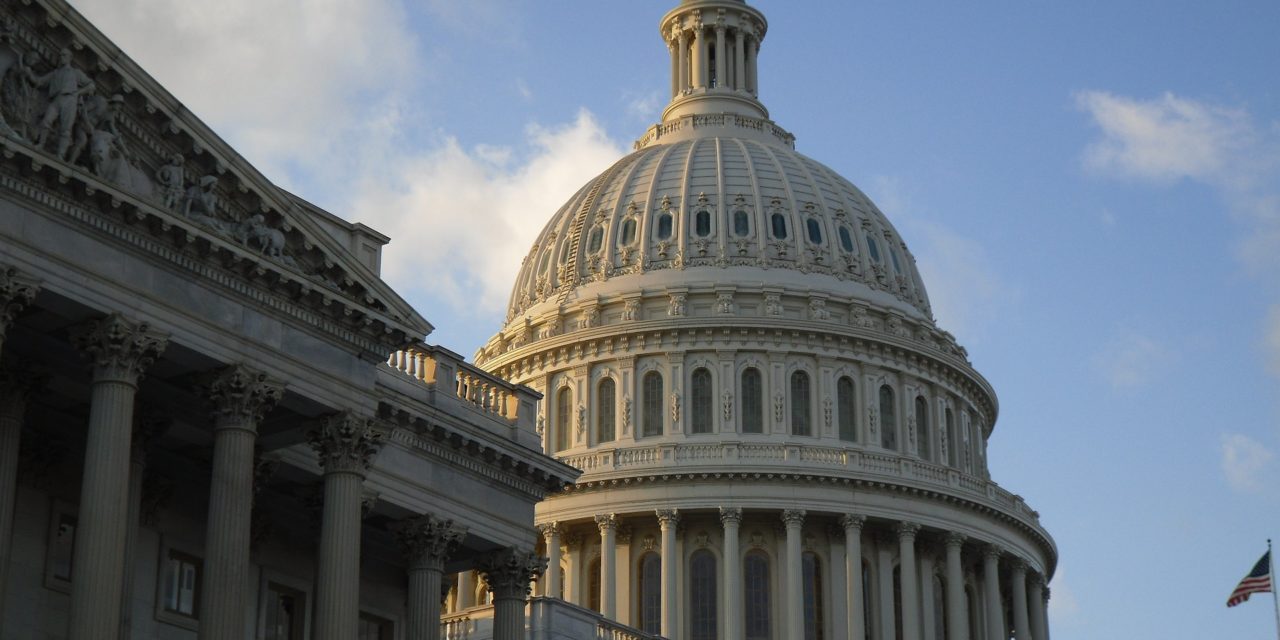

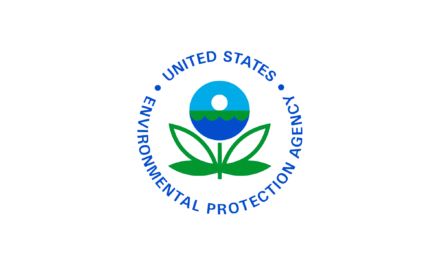


Recent Comments